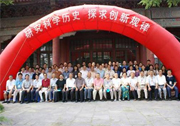| 中文题目: | 旧学新知:明清番薯种莳与藏种知识的生产及传播 | ||||||
| 英文题目: | New Techniques Based on Existing Knowledge:Production and Dissemination of the Methods of Sweet Potato Cultivation andRoots/Slips Storage in the Ming and Qing Dynasties | ||||||
| 作 者: | 杜新豪,李昕升 | ||||||
| 刊物名称: | 自然科学史研究 | ||||||
| 发表年度: | 2023-03-15 | ||||||
| 卷: | 42 | ||||||
| 期: | 01 | ||||||
| 页码: | 54-63 | ||||||
| 中文摘要: | 番薯原产于热带美洲地区,明代中后期经东南亚传入中国。作为一种无性繁殖的块根作物,其种植技术与中国传统以“五谷”为代表的谷类种植法有所不同。在传入初期,农学家围绕其“栽种法则”进行了一系列探索,实现了种植技术的本土化;嗣后在其北传的过程中,闽浙的越冬留种法并不适用于寒冷的北方地区,当地人们逐渐摸索出窖藏的技术来保存薯种。明清时期形成的番薯栽培与留种技术并不是全然的“新知”,中国传统薯蓣作物种植法、储谷法、冬季窖菜法与块茎作物留种法等“旧学”皆为番薯新知识的生成提供了有益借鉴。藉由此,本文提出应以动态的观念审视新作物种植技术的生成过程,为考察外来作物的栽培技术史提供一个新视角。 |
||||||
| 英文摘要: | Native to the tropical regions of the Americas,sweet potatoes were introduced intoChina via Southeast Asia in the mid-and late-Ming dynasty.Since sweet potatoes are a tuberous rootcrop featuring asexual reproduction,their cultivation techniques were different from traditionalChinese cultivation methods for cereals,represented by the five grains.When sweet potatoes firstarrived in China,agronomists made a variety of attempts to develop“cultivation methods”for sweetpotatoes,eventually achieving localized planting techniques.Later,when sweet potatoes wereintroduced northwards,the overwinter roots/slips storage method used in Fujian and Zhejiangprovinces was no longer applicable in the colder northern provinces,where local farmers graduallybegan to store sweet potato roots/slips in cellars.These cultivation and roots/slips storage techniquesthat came into being in the Ming and Qing dynasties were,in fact,not brand-new.Rather,someexisting knowledge,including China's traditional methods of planting yams,cereal storage methods,the method of keeping vegetables in cellars in winter,and root storage methods for crops withtuberous roots all served as helpful references for the formation of sweet potato-related newknowledge.As such,this article suggests that a dynamic viewpoint be adopted when studying thedevelopment of the cultivation methods of any new crops,and hence offers a new perspective forinvestigating the cultivation technology history of foreign crops. |
||||||





